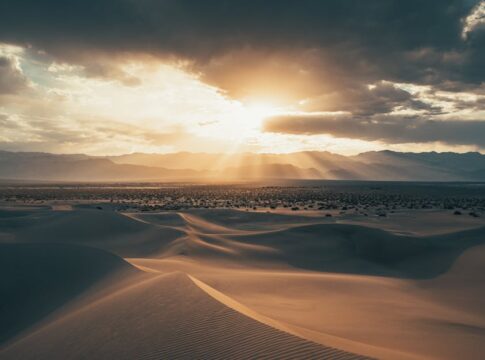⏱️ 5 min read
When most people think of Antarctica, they envision endless ice sheets, howling blizzards, and sub-zero temperatures. The last thing that comes to mind is a desert. Yet, nestled within this frozen continent lies one of Earth’s most extraordinary and counterintuitive landscapes: the McMurdo Dry Valleys, the largest ice-free region in Antarctica and one of the world’s most extreme deserts.
Understanding What Makes a Desert
Before exploring Antarctica’s surprising desert landscape, it’s essential to understand what actually defines a desert. Contrary to popular belief, deserts are not characterized by heat or sand, but rather by precipitation—or the lack thereof. Technically, a desert is any region that receives less than 250 millimeters (10 inches) of precipitation annually. This definition encompasses hot sandy deserts like the Sahara, cold deserts like the Gobi, and even the polar deserts of Antarctica.
Antarctica holds the distinction of being the driest continent on Earth. While the coastal regions receive some snowfall, the interior of the continent is remarkably arid. The McMurdo Dry Valleys, in particular, receive almost no precipitation at all, with some areas having seen no rain or snow for nearly two million years.
The McMurdo Dry Valleys: Antarctica’s Desert Landscape
The McMurdo Dry Valleys comprise approximately 4,800 square kilometers of ice-free terrain in the Transantarctic Mountains of Eastern Antarctica. These valleys—including Victoria Valley, Wright Valley, and Taylor Valley—present a stark, alien landscape that more closely resembles Mars than typical Antarctic scenery.
The valleys are characterized by exposed bedrock, gravel-strewn ground, and peculiar geological formations sculpted by wind erosion rather than ice. The soil here is so dry and sterile that it’s considered one of the closest terrestrial analogs to the Martian surface, making it a valuable research site for scientists studying potential life on other planets.
Why Do These Valleys Remain Ice-Free?
The existence of ice-free valleys in Antarctica seems paradoxical, but several factors combine to create and maintain these unique conditions. The primary reason is the presence of katabatic winds—powerful gravity-driven winds that flow down from the polar plateau at speeds exceeding 320 kilometers per hour. These winds are among the fastest and driest on Earth.
As these katabatic winds descend from the high interior plateau, they warm slightly through compression and effectively sublimate any snow or ice in their path. The moisture is stripped away before it can accumulate, leaving bare rock and soil exposed. Additionally, the Transantarctic Mountains block glacial ice from flowing into the valleys from the polar ice sheet, further contributing to their ice-free status.
The combination of extremely low humidity, minimal precipitation, and these fierce desiccating winds creates what scientists call a “hyper-arid polar desert,” making the McMurdo Dry Valleys drier than even the Atacama Desert in Chile, which is often cited as the driest place on Earth.
Extreme Environmental Conditions
The McMurdo Dry Valleys experience some of the most extreme environmental conditions on the planet. Average annual temperatures hover around -20°C (-4°F), though summer temperatures can occasionally rise above freezing. The relative humidity is often below 50%, and in some areas, it can drop to as low as 10%, comparable to the world’s hottest deserts.
The valleys receive less than 100 millimeters of water equivalent precipitation per year, with some areas receiving virtually none. This extreme aridity, combined with the constant scouring by katabatic winds, creates an environment that is incredibly hostile to life. The soil contains almost no organic material, and traditional plant life cannot survive.
Surprising Signs of Life
Despite the harsh conditions, life finds a way to persist in the McMurdo Dry Valleys, albeit in microscopic forms. Scientists have discovered several remarkable examples of extremophile organisms:
- Endolithic bacteria and fungi that live inside porous rocks, protected from the harsh external environment
- Algae and cyanobacteria surviving in cryptoendolithic communities within sandstone
- Simple organisms in hypersaline ponds that remain liquid even in freezing temperatures due to their high salt content
- Bacterial mats in permanently ice-covered lakes where nutrients filter through the ice
These organisms have developed extraordinary adaptations to survive in this extreme environment, including the ability to remain dormant for extended periods and metabolize at extremely low temperatures.
Scientific Significance and Research
The McMurdo Dry Valleys serve as an invaluable natural laboratory for multiple scientific disciplines. Geologists study the valleys to understand climate change patterns, as the ice-free conditions preserve geological records spanning millions of years. The lack of vegetation and precipitation means that geological processes can be observed in their purest form.
Astrobiologists are particularly interested in the region because its extreme conditions closely mimic those found on Mars and other planets. Research conducted here helps scientists understand the limits of life and informs the search for extraterrestrial organisms. NASA has used the Dry Valleys as a testing ground for equipment destined for Mars missions.
Climate scientists also monitor the valleys closely, as they serve as sensitive indicators of global climate change. Any increase in temperature or precipitation could dramatically alter these ancient landscapes, providing early warnings of broader environmental shifts.
A Protected Wilderness
Recognizing their unique scientific value, the McMurdo Dry Valleys have been designated as an Antarctic Specially Managed Area under the Antarctic Treaty System. Access is strictly controlled, and researchers must follow rigorous protocols to minimize contamination and environmental impact. This protection ensures that these remarkable desert landscapes will remain available for future scientific study and continue to reveal their secrets about Earth’s past and the potential for life beyond our planet.
The existence of a desert in Antarctica challenges our preconceptions about both deserts and the frozen continent, reminding us that Earth’s geography is far more diverse and surprising than we might imagine.

